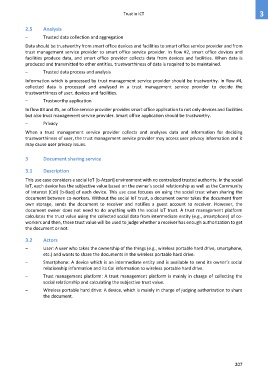Page 215 - Trust in ICT 2017
P. 215
Trust in ICT 3
2.5 Analysis
– Trusted data collection and aggregation
Data should be trustworthy from smart office devices and facilities to smart office service provider and from
trust management service provider to smart office service provider. In flow #2, smart office devices and
facilities produce data, and smart office provider collects data from devices and facilities. When data is
produced and transmitted to other entities, trustworthiness of data is required to be maintained.
– Trusted data process and analysis
Information which is processed by trust management service provider should be trustworthy. In flow #4,
collected data is processed and analysed in a trust management service provider to decide the
trustworthiness of user, devices and facilities.
– Trustworthy application
In flow #3 and #5, an office service provider provides smart office application to not only devices and facilities
but also trust management service provider. Smart office application should be trustworthy.
– Privacy
When a trust management service provider collects and analyses data and information for deciding
trustworthiness of user, the trust management service provider may access user privacy information and it
may cause user privacy issues.
3 Document sharing service
3.1 Description
This use case considers a social IoT [b-Atzori] environment with no centralized trusted authority. In the social
IoT, each device has the subjective value based on the owner's social relationship as well as the Community
of Interest (CoI) [b-Bao] of each device. This use case focuses on using the social trust when sharing the
document between co-workers. Without the social IoT trust, a document owner takes the document from
own storage, sends the document to receiver and notifies a guest account to receiver. However, the
document owner does not need to do anything with the social IoT trust. A trust management platform
calculates the trust value using the collected social data from intermediate entity (e.g., smartphone) of co-
workers and then, these trust value will be used to judge whether a receiver has enough authorization to get
the document or not.
3.2 Actors
– User: A user who takes the ownership of the things (e.g., wireless portable hard drive, smartphone,
etc.) and wants to share the documents in the wireless portable hard drive.
– Smartphone: A device which is an intermediate entity and is available to send its owner’s social
relationship information and its CoI information to wireless portable hard drive.
– Trust management platform: A trust management platform is mainly in charge of collecting the
social relationship and calculating the subjective trust value.
– Wireless portable hard drive: A device, which is mainly in charge of judging authorization to share
the document.
207

